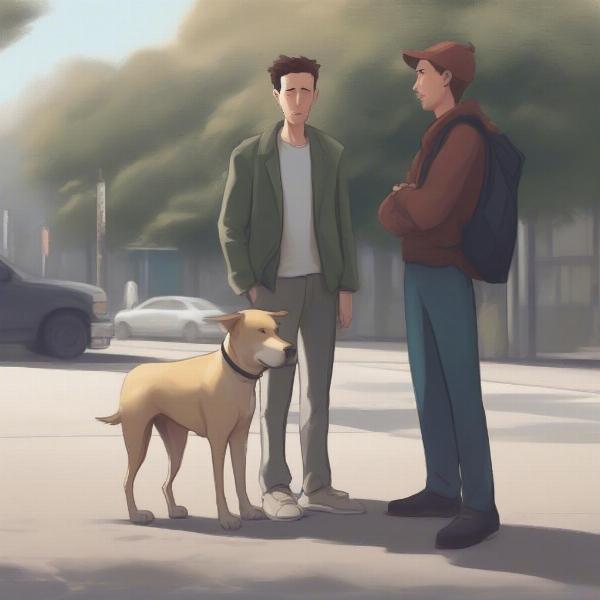Protecting their family is ingrained in a dog’s DNA. While most dogs won’t fend off a burglar with the ferocity of a trained guard dog, they still possess inherent protective instincts. Understanding these subtle cues can deepen your bond and help you appreciate your furry friend’s unwavering loyalty. This article will delve into the common signs your dog is protecting you, exploring their body language, vocalizations, and behavioral changes.
Decoding Your Dog’s Protective Behaviors
Dogs communicate primarily through non-verbal cues. Recognizing these subtle shifts in body language is key to understanding their protective instincts. A dog displaying protective behavior might position themselves between you and a perceived threat, even if that “threat” is just a friendly stranger. They might also stiffen their body, raise their hackles (the fur along their back), and hold their tail high and rigid. Other subtle signs include intense staring, a furrowed brow, and dilated pupils.
 Dog Standing Between Owner and Stranger
Dog Standing Between Owner and Stranger
While some dogs become overtly protective, displaying aggressive behaviors like growling, barking, or snapping, others demonstrate their protective instincts more subtly. A dog might simply become more clingy, following you closely, or resting their head on your lap. They might also become more alert, constantly scanning their surroundings and reacting to even the slightest noises.
Vocalizations: A Dog’s Protective Bark
Barking is a dog’s primary way of vocalizing, and the tone and frequency of their bark can offer valuable insights into their emotional state. A protective bark is typically deep, loud, and persistent, designed to deter potential threats. It’s often accompanied by other protective behaviors, such as growling or baring teeth. However, not all barks are signs of protection. It’s important to differentiate between a protective bark and a bark caused by excitement, playfulness, or anxiety.
Subtle Shifts in Behavior
Beyond body language and vocalizations, subtle shifts in your dog’s behavior can also indicate they’re in protective mode. A typically friendly dog might suddenly become wary of strangers, refusing to greet them or even hiding behind you. They might also become more possessive of their toys or food, guarding them closely and growling if anyone approaches. These changes in behavior, while subtle, can be clear indicators of your dog’s protective instincts.
When Protective Behavior Becomes a Problem
While a certain degree of protective behavior is natural and even desirable in a dog, excessive or aggressive protectiveness can be problematic. If your dog’s protective instincts are causing issues, such as aggression towards strangers or excessive barking, it’s crucial to seek professional help. A qualified dog trainer or behaviorist can assess the situation and develop a customized training plan to address the underlying causes of the behavior and help your dog learn to manage their protective instincts in a healthy and appropriate way. natural flea and tick prevention for dogs canada
Conclusion
Understanding the signs your dog is protecting you can strengthen your bond and enhance your ability to communicate effectively with your furry companion. By recognizing their subtle cues, you can appreciate their unwavering loyalty and ensure they’re expressing their protective instincts in a healthy and appropriate manner. Remember, a well-balanced dog is a happy dog, and by addressing any problematic protective behaviors early on, you can help your dog thrive in a social environment. ware of the dog dog keep off grass signs repellent for dog pee small dog boots that stay on
FAQ
- How can I tell if my dog’s barking is protective or due to something else? Consider the context. Is there a perceived threat? Are they displaying other protective behaviors like a stiff body or raised hackles?
- Is it normal for my dog to be protective of me? Yes, a certain level of protectiveness is instinctive in dogs.
- What should I do if my dog’s protective behavior is becoming a problem? Consult a qualified dog trainer or behaviorist.
- Can protective behavior be trained out of a dog? While the instinct can’t be eliminated, it can be managed through training.
- Are certain breeds more protective than others? Yes, some breeds are naturally more predisposed to protective behaviors.
- How can I encourage healthy protective behavior in my dog? Focus on positive reinforcement training and socialization.
- Should I punish my dog for being protective? No, punishment can worsen the behavior. Focus on positive reinforcement and redirection.
ILM Dog is your trusted resource for all things dog-related. We offer expert advice on dog breeds, health, training, nutrition, grooming, and much more. Whether you’re a new dog owner or a seasoned pro, ILM Dog provides valuable insights and practical tips to help you provide the best possible care for your canine companion. From understanding the nuances of dog behavior to choosing the right products and accessories, we’re here to support you every step of the way. Contact us today for personalized advice: Email: [email protected], Phone: +44 20-3965-8624. Visit ILM Dog for all your dog care needs!